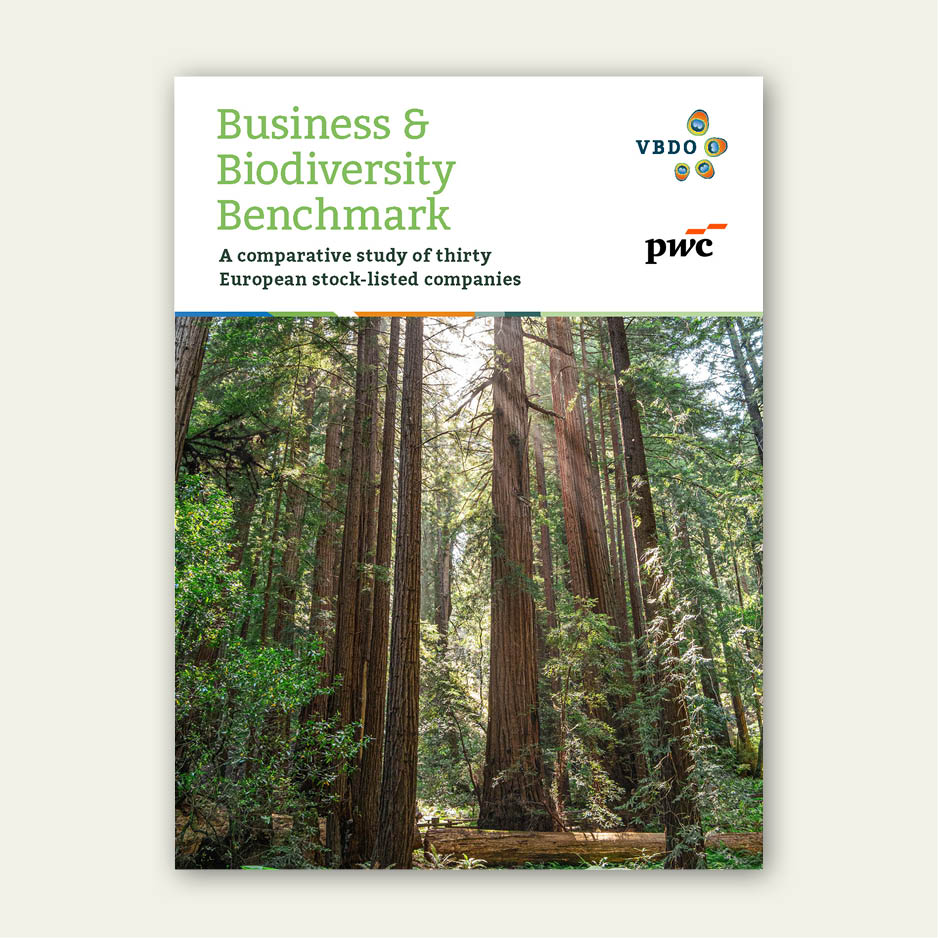- 73% of companies acknowledge biodiversity as a material issue, yet only 50% have formal transition plans.
- Few companies use measurable biodiversity indicators—most rely on vague terms like “no net loss”.
- The pharmaceutical sector lags, while Extractives and Food & Beverage show stronger performance.
- Only 4 out of 30 companies consider location-specific biodiversity impacts in their value chains.
- JDE Peet’s, Danone, and Carrefour lead the 2025 benchmark with the highest biodiversity scores.
Utrecht, November 20th, 2025 – More than half of the world’s economy depends on healthy ecosystems. As these systems degrade, the foundation of our prosperity and well-being weakens. Biodiversity loss is accelerating, and with it, the risks to our economies and businesses. A groundbreaking new benchmark by the Dutch Association of Investors for Sustainable Development (VBDO), in collaboration with PwC Netherlands, reveals that while biodiversity is rapidly moving up the corporate agenda, most listed European companies remain stuck in the commitment phase, lacking clear metrics or measurable action.
Biodiversity Loss: A Global Business Risk
The first edition of the Business & Biodiversity Benchmark evaluates 30 European-listed companies across the Food & Beverage, Extractive, and Pharmaceutical sectors. It ranks corporate performance on biodiversity strategy, policy, actions, and targets. Offering, for the first time, a sector-specific snapshot of how business is responding to accelerating biodiversity loss. “This benchmark is not just a ranking—it’s a reality check. As ecosystems degrade, so does the foundation of long-term economic stability,” said Angélique Laskewitz, Executive Director of VBDO. “This benchmark shows that companies recognise the risk, but very few translate this into real, measurable outcomes. To remain resilient, companies must treat biodiversity as a strategic asset.”
Awareness Is Rising, Action Is Lagging
73% of companies identify biodiversity as a material issue—but only 50% have biodiversity transition plans. Most targets are still vague, relying on broad terms like “no net loss” without clear baselines or timelines. Just a few frontrunners like JDE Peet’s, Danone, and Carrefour use biodiversity indicators that are specific, measurable, and comparable. Extractive sector companies generally score highest, due to direct regulatory exposure. Food & Beverage companies show growing awareness through supply chain policies. Pharmaceutical companies lag. Only four companies consider location-specific biodiversity impacts in their value chains, even though most biodiversity risks lie beyond direct operations.
JDE Peet’s Top Performer on Biodiversity
JDE Peet’s leads the 2025 ranking with a score of 79%, followed closely by Danone (78.4%) and Carrefour (73.6%). At the other end of the scale, several companies score below 25%, exposing a stark divide between leaders and laggards. “Nature is not a niche concern – it is foundational to our economy, wellbeing, and future. Realising the business case for biodiversity requires leadership, creativity, and a willingness to step outside traditional silos. Our benchmark with VBDO highlights where organisations stand today and provides actionable insights to turn ambition into impact,” said Alexander Spek, Partner at PwC Netherlands.
A Wake-Up Call for Corporate Europe
The publication arrives at a critical moment. Biodiversity loss is now considered the second-highest global risk for the coming decade, after climate change. With more than 50% of global GDP dependent on healthy ecosystems, companies face material threats from supply chain instability to regulatory scrutiny and investor pressure. The benchmark aligns with leading disclosure frameworks, including the Corporate Sustainability Reporting Directive (CSRD), the Taskforce on Nature-related Financial Disclosures (TNFD), and Science-Based Targets for Nature (SBTN). It sets a new standard for evaluating, comparing, and improving biodiversity performance across sectors.
From Words to Impact
The report urges companies to consult stakeholders and local communities to develop biodiversity transition plans grounded in real-world contexts and risks. Develop standardised metrics and baselines aligned with TNFD and SBTN methodologies, moving beyond vague commitments to concrete performance indicators. The Business & Biodiversity Benchmark 2025 offers companies a mirror and, at the same time, delivers a clear roadmap, highlighting where companies stand and how they can lead. With the window for meaningful action rapidly closing, the report serves as both a warning and a guide toward a nature-positive future.

